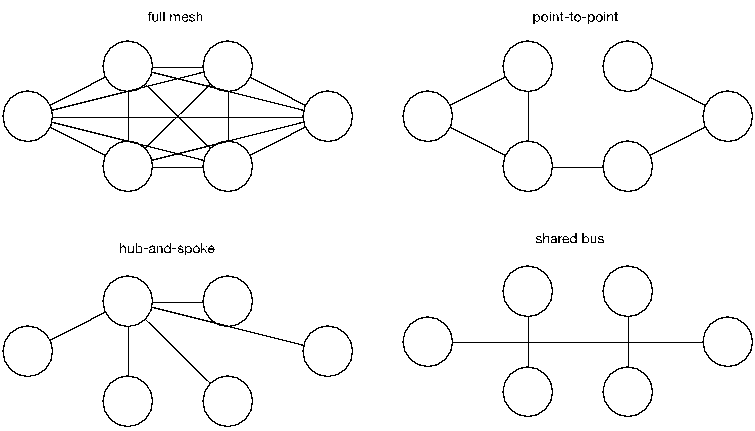Page History
Anchor
...
When
...
One
...
Party
...
Wants
...
to
...
Release Early
...
...
Communication
...
Topology
...
Anchor
The CERT/CC has historically applied a hub-and-spoke approach to coordination for cases where it was feasible to maintain separate conversations with the affected parties. Maintaining a hub-and-spoke coordination topology for each distinct case requires some forethought into tools and practices, though—you can't just carbon-copy everybody, and without good tracking tools, keeping tabs on who knows what can be difficult. A hub-and-spoke topology allows a coordinator to maintain operational security since each conversation has only two participants: the coordinator and the other party. The tradeoff is that the coordinator (hub) can easily become a bottleneck during especially active coordination situations.
Some of the larger coordination efforts we have encountered have required more of a shared-bus approach through the use of conference calls, group meetings, and private mailing lists. This approach puts the CVD participants in direct contact with each other rather than having a coordinator acting as a proxy for all communications while minimizing the communication overhead. A shared-bus approach can increase the efficiency of communications, but can on occasion make it harder to reach agreement on what is to be done.
...
...
Motivating Synchronized Release
...
CVD
...
process
...
discussions
...
tend
...
to
...
focus
...
on
...
the
...
handling
...
of
...
individual
...
vulnerability
...
cases
...
rather
...
than
...
the
...
social
...
fabric
...
surrounding
...
vulnerability
...
coordination
...
we
...
construct
...
over
...
time.
...
Shifting
...
away
...
from
...
the
...
individual
...
units
...
of
...
work
...
to
...
the
...
social
...
structure
...
can
...
suggest
...
a
...
way
...
out
...
of
...
some
...
of
...
the
...
more
...
contentious
...
points
...
in
...
any
...
given
...
case.
...
We
...
previously
...
described
...
the
...
multiparty
...
delay
...
problem.
...
Game
...
theory
...
provides
...
us
...
with
...
the
...
prisoners'
...
dilemma
...
as
...
model
...
for
...
thinking
...
about
...
this
...
concern.
...
The
...
main
...
takeaway
...
from
...
research
...
into
...
the
...
prisoners'
...
dilemma
...
is
...
that
...
by
...
shifting
...
one's
...
perspective
...
to
...
considering
...
a
...
repeated
...
game,
...
it's
...
possible
...
to
...
find
...
better
...
solutions
...
than
...
would
...
be
...
possible
...
in
...
a
...
one-shot
...
game
...
with
...
no
...
history.
...
The
...
recognition
...
that
...
it's
...
a
...
repeated
...
game
...
leads
...
to
...
improved
...
cooperation
...
among
...
players
...
who
...
would
...
otherwise
...
be
...
motivated
...
to
...
act
...
solely
...
in
...
their
...
own
...
self-interest
...
in
...
each
...
round
...
[
...
1].
...
One
...
approach
...
we've
...
found
...
to
...
work
...
is
...
to
...
remind
...
the
...
parties
...
involved
...
that
...
this
...
will
...
likely
...
not
...
be
...
the
...
last
...
multiparty
...
vulnerability
...
coordination
...
effort
...
in
...
which
...
they
...
find
...
themselves.
...
A
...
vendor
...
that
...
repeatedly
...
releases
...
early
...
will
...
likely
...
get
...
left
...
out
...
of
...
future
...
coordination
...
efforts.
...
Because
...
of
...
this,
...
the
...
quicker
...
vendors
...
might
...
be
...
motivated
...
to
...
delay
...
so
...
they
...
get
...
the
...
vulnerability
...
information
...
the
...
next
...
time.
...
Perhaps
...
most
...
important
...
for
...
those
...
wanting
...
to
...
release
...
early
...
is
...
to
...
remember
...
that
...
this
...
is
...
a
...
repeated
...
game;
...
you
...
might
...
be
...
first
...
one
...
ready
...
to
...
publish
...
this
...
time
...
but
...
that
...
may
...
not
...
always
...
be
...
the
...
case.
...
Consideration
...
for
...
the
...
other
...
parties
...
involved
...
in
...
any
...
given
...
case
...
can
...
yield
...
better
...
outcomes
...
in
...
the
...
long
...
run.
...
In
...
the
...
end,
...
everyone
...
benefits
...
from
...
vendors
...
improving
...
their
...
vulnerability
...
response
...
processes,
...
so
...
helping
...
the
...
laggards
...
become
...
more
...
efficient
...
can
...
sometimes
...
become
...
a
...
secondary
...
goal
...
of
...
the
...
coordination
...
process.
| Panel | ||
|---|---|---|
| ||
< 5.4 Multiparty CVD | 5.6 Maintaining Pre-Disclosure Secrecy > |
References
- R. M. Axelrod, The Evolution of Cooperation, Revised ed., Basic books, 2006.
